Exploring Transactional, Charismatic, and Transformational Leadership
VerifiedAdded on 2022/09/23
|5
|1750
|26
Essay
AI Summary
This essay critically analyzes three prominent leadership styles: transactional, charismatic, and transformational. It examines the 'give and take' relationship inherent in transactional leadership, noting its potential demotivating effects when employees are penalized for poor performance, while also acknowledging its effectiveness in achieving organizational goals. Charismatic leadership, characterized by persuasiveness and emotional influence, is compared to transformational leadership, highlighting the former's stronger command over its audience. The essay emphasizes the importance of understanding employees' evolving needs and expectations. Transformational leadership, less dependent on organizational circumstances, fosters trust and mutual growth between leaders and followers. The essay concludes by stressing the need to consider psychological factors, leader-employee relationships, and situational contexts when analyzing leadership effectiveness across these three styles.
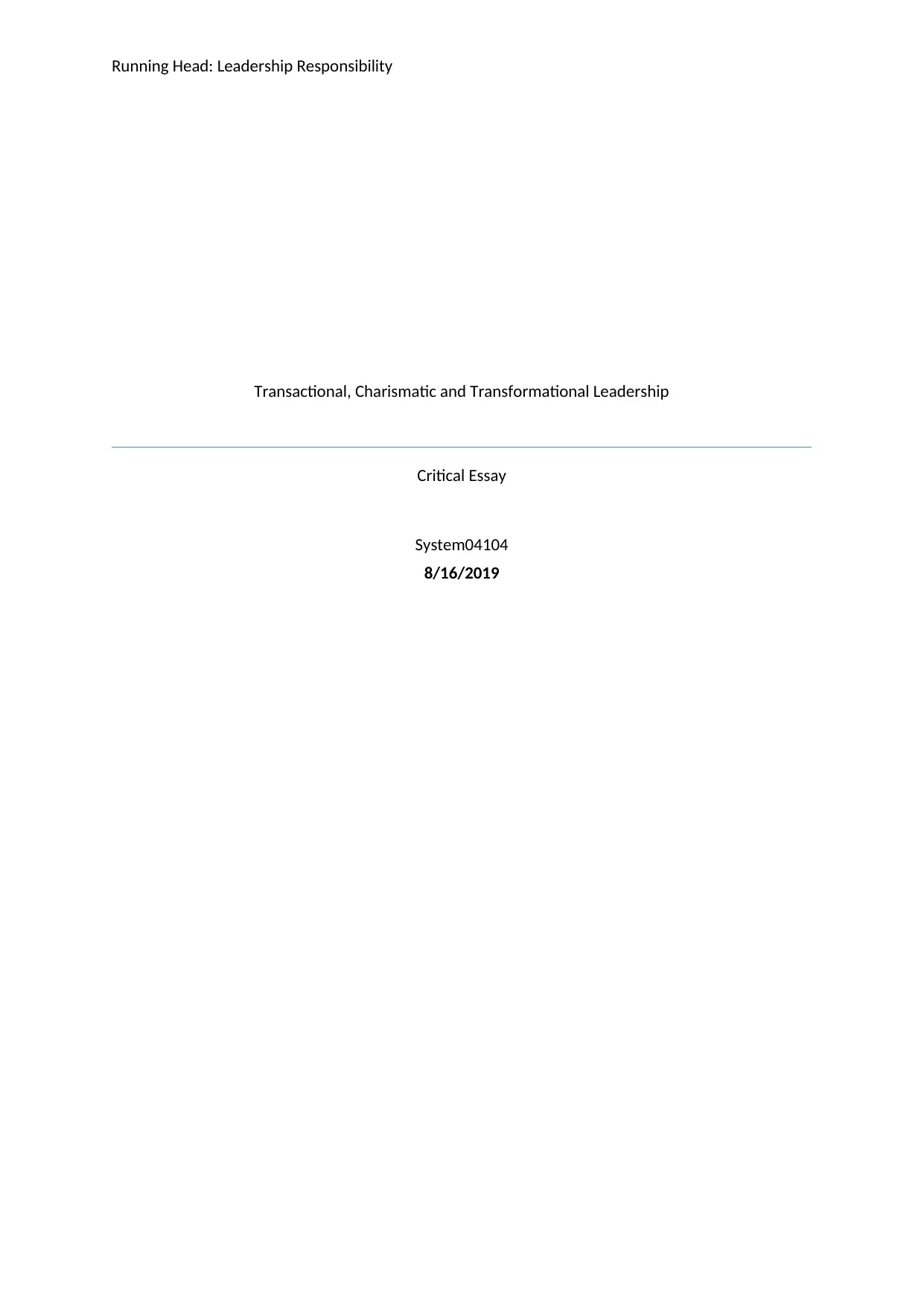
Running Head: Leadership Responsibility
Transactional, Charismatic and Transformational Leadership
Critical Essay
System04104
8/16/2019
Transactional, Charismatic and Transformational Leadership
Critical Essay
System04104
8/16/2019
Paraphrase This Document
Need a fresh take? Get an instant paraphrase of this document with our AI Paraphraser
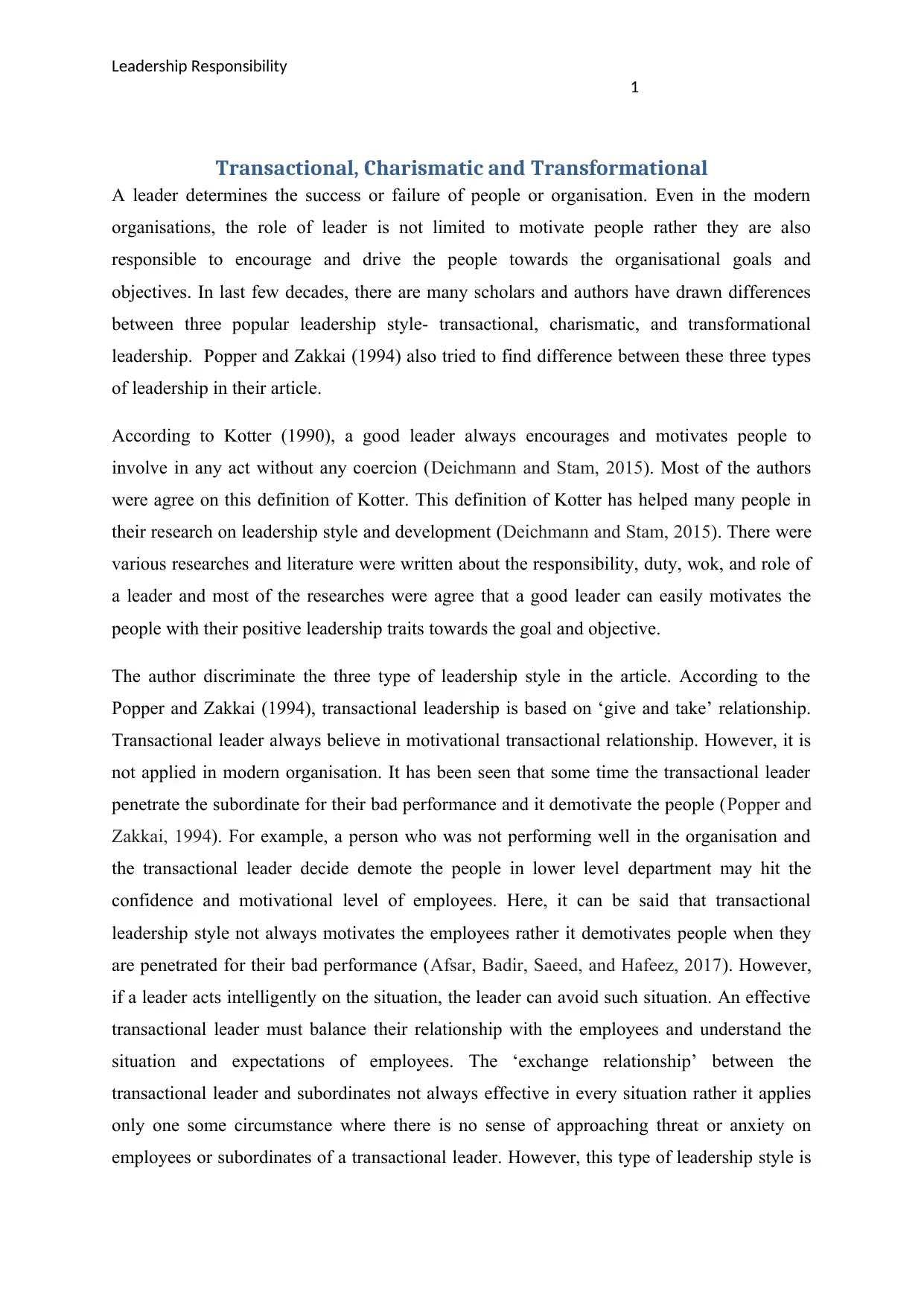
Leadership Responsibility
1
Transactional, Charismatic and Transformational
A leader determines the success or failure of people or organisation. Even in the modern
organisations, the role of leader is not limited to motivate people rather they are also
responsible to encourage and drive the people towards the organisational goals and
objectives. In last few decades, there are many scholars and authors have drawn differences
between three popular leadership style- transactional, charismatic, and transformational
leadership. Popper and Zakkai (1994) also tried to find difference between these three types
of leadership in their article.
According to Kotter (1990), a good leader always encourages and motivates people to
involve in any act without any coercion (Deichmann and Stam, 2015). Most of the authors
were agree on this definition of Kotter. This definition of Kotter has helped many people in
their research on leadership style and development (Deichmann and Stam, 2015). There were
various researches and literature were written about the responsibility, duty, wok, and role of
a leader and most of the researches were agree that a good leader can easily motivates the
people with their positive leadership traits towards the goal and objective.
The author discriminate the three type of leadership style in the article. According to the
Popper and Zakkai (1994), transactional leadership is based on ‘give and take’ relationship.
Transactional leader always believe in motivational transactional relationship. However, it is
not applied in modern organisation. It has been seen that some time the transactional leader
penetrate the subordinate for their bad performance and it demotivate the people (Popper and
Zakkai, 1994). For example, a person who was not performing well in the organisation and
the transactional leader decide demote the people in lower level department may hit the
confidence and motivational level of employees. Here, it can be said that transactional
leadership style not always motivates the employees rather it demotivates people when they
are penetrated for their bad performance (Afsar, Badir, Saeed, and Hafeez, 2017). However,
if a leader acts intelligently on the situation, the leader can avoid such situation. An effective
transactional leader must balance their relationship with the employees and understand the
situation and expectations of employees. The ‘exchange relationship’ between the
transactional leader and subordinates not always effective in every situation rather it applies
only one some circumstance where there is no sense of approaching threat or anxiety on
employees or subordinates of a transactional leader. However, this type of leadership style is
1
Transactional, Charismatic and Transformational
A leader determines the success or failure of people or organisation. Even in the modern
organisations, the role of leader is not limited to motivate people rather they are also
responsible to encourage and drive the people towards the organisational goals and
objectives. In last few decades, there are many scholars and authors have drawn differences
between three popular leadership style- transactional, charismatic, and transformational
leadership. Popper and Zakkai (1994) also tried to find difference between these three types
of leadership in their article.
According to Kotter (1990), a good leader always encourages and motivates people to
involve in any act without any coercion (Deichmann and Stam, 2015). Most of the authors
were agree on this definition of Kotter. This definition of Kotter has helped many people in
their research on leadership style and development (Deichmann and Stam, 2015). There were
various researches and literature were written about the responsibility, duty, wok, and role of
a leader and most of the researches were agree that a good leader can easily motivates the
people with their positive leadership traits towards the goal and objective.
The author discriminate the three type of leadership style in the article. According to the
Popper and Zakkai (1994), transactional leadership is based on ‘give and take’ relationship.
Transactional leader always believe in motivational transactional relationship. However, it is
not applied in modern organisation. It has been seen that some time the transactional leader
penetrate the subordinate for their bad performance and it demotivate the people (Popper and
Zakkai, 1994). For example, a person who was not performing well in the organisation and
the transactional leader decide demote the people in lower level department may hit the
confidence and motivational level of employees. Here, it can be said that transactional
leadership style not always motivates the employees rather it demotivates people when they
are penetrated for their bad performance (Afsar, Badir, Saeed, and Hafeez, 2017). However,
if a leader acts intelligently on the situation, the leader can avoid such situation. An effective
transactional leader must balance their relationship with the employees and understand the
situation and expectations of employees. The ‘exchange relationship’ between the
transactional leader and subordinates not always effective in every situation rather it applies
only one some circumstance where there is no sense of approaching threat or anxiety on
employees or subordinates of a transactional leader. However, this type of leadership style is
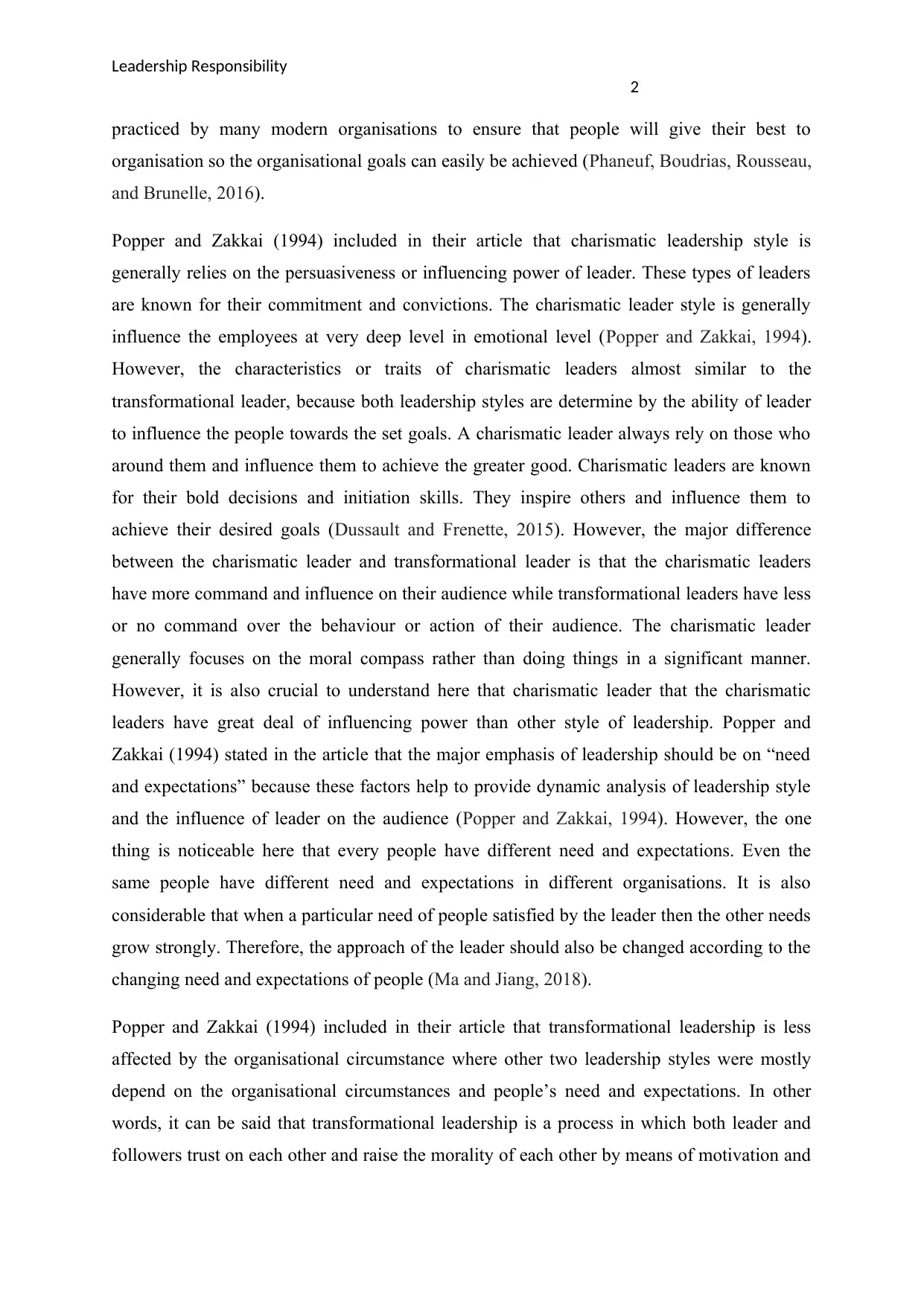
Leadership Responsibility
2
practiced by many modern organisations to ensure that people will give their best to
organisation so the organisational goals can easily be achieved (Phaneuf, Boudrias, Rousseau,
and Brunelle, 2016).
Popper and Zakkai (1994) included in their article that charismatic leadership style is
generally relies on the persuasiveness or influencing power of leader. These types of leaders
are known for their commitment and convictions. The charismatic leader style is generally
influence the employees at very deep level in emotional level (Popper and Zakkai, 1994).
However, the characteristics or traits of charismatic leaders almost similar to the
transformational leader, because both leadership styles are determine by the ability of leader
to influence the people towards the set goals. A charismatic leader always rely on those who
around them and influence them to achieve the greater good. Charismatic leaders are known
for their bold decisions and initiation skills. They inspire others and influence them to
achieve their desired goals (Dussault and Frenette, 2015). However, the major difference
between the charismatic leader and transformational leader is that the charismatic leaders
have more command and influence on their audience while transformational leaders have less
or no command over the behaviour or action of their audience. The charismatic leader
generally focuses on the moral compass rather than doing things in a significant manner.
However, it is also crucial to understand here that charismatic leader that the charismatic
leaders have great deal of influencing power than other style of leadership. Popper and
Zakkai (1994) stated in the article that the major emphasis of leadership should be on “need
and expectations” because these factors help to provide dynamic analysis of leadership style
and the influence of leader on the audience (Popper and Zakkai, 1994). However, the one
thing is noticeable here that every people have different need and expectations. Even the
same people have different need and expectations in different organisations. It is also
considerable that when a particular need of people satisfied by the leader then the other needs
grow strongly. Therefore, the approach of the leader should also be changed according to the
changing need and expectations of people (Ma and Jiang, 2018).
Popper and Zakkai (1994) included in their article that transformational leadership is less
affected by the organisational circumstance where other two leadership styles were mostly
depend on the organisational circumstances and people’s need and expectations. In other
words, it can be said that transformational leadership is a process in which both leader and
followers trust on each other and raise the morality of each other by means of motivation and
2
practiced by many modern organisations to ensure that people will give their best to
organisation so the organisational goals can easily be achieved (Phaneuf, Boudrias, Rousseau,
and Brunelle, 2016).
Popper and Zakkai (1994) included in their article that charismatic leadership style is
generally relies on the persuasiveness or influencing power of leader. These types of leaders
are known for their commitment and convictions. The charismatic leader style is generally
influence the employees at very deep level in emotional level (Popper and Zakkai, 1994).
However, the characteristics or traits of charismatic leaders almost similar to the
transformational leader, because both leadership styles are determine by the ability of leader
to influence the people towards the set goals. A charismatic leader always rely on those who
around them and influence them to achieve the greater good. Charismatic leaders are known
for their bold decisions and initiation skills. They inspire others and influence them to
achieve their desired goals (Dussault and Frenette, 2015). However, the major difference
between the charismatic leader and transformational leader is that the charismatic leaders
have more command and influence on their audience while transformational leaders have less
or no command over the behaviour or action of their audience. The charismatic leader
generally focuses on the moral compass rather than doing things in a significant manner.
However, it is also crucial to understand here that charismatic leader that the charismatic
leaders have great deal of influencing power than other style of leadership. Popper and
Zakkai (1994) stated in the article that the major emphasis of leadership should be on “need
and expectations” because these factors help to provide dynamic analysis of leadership style
and the influence of leader on the audience (Popper and Zakkai, 1994). However, the one
thing is noticeable here that every people have different need and expectations. Even the
same people have different need and expectations in different organisations. It is also
considerable that when a particular need of people satisfied by the leader then the other needs
grow strongly. Therefore, the approach of the leader should also be changed according to the
changing need and expectations of people (Ma and Jiang, 2018).
Popper and Zakkai (1994) included in their article that transformational leadership is less
affected by the organisational circumstance where other two leadership styles were mostly
depend on the organisational circumstances and people’s need and expectations. In other
words, it can be said that transformational leadership is a process in which both leader and
followers trust on each other and raise the morality of each other by means of motivation and
⊘ This is a preview!⊘
Do you want full access?
Subscribe today to unlock all pages.

Trusted by 1+ million students worldwide
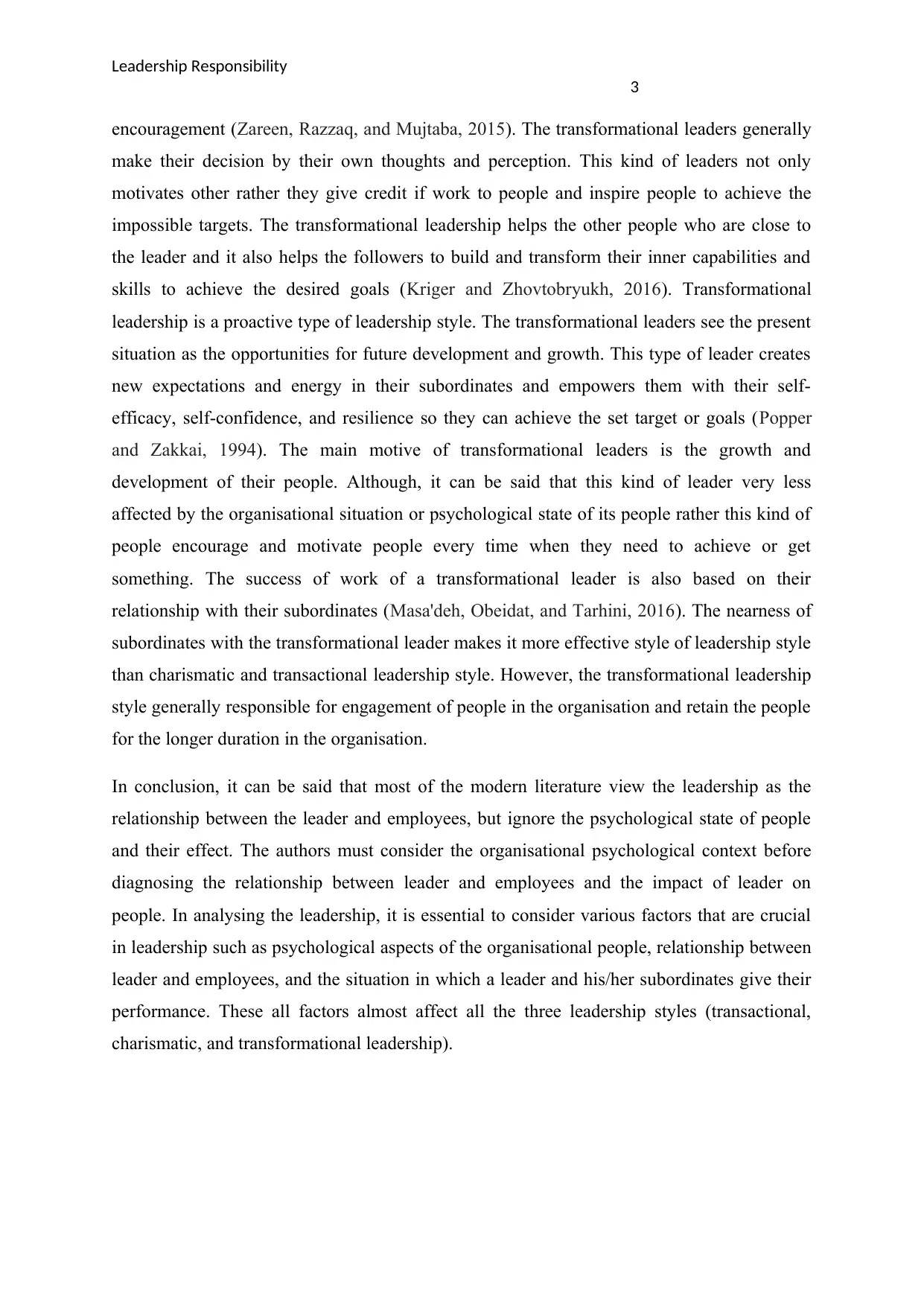
Leadership Responsibility
3
encouragement (Zareen, Razzaq, and Mujtaba, 2015). The transformational leaders generally
make their decision by their own thoughts and perception. This kind of leaders not only
motivates other rather they give credit if work to people and inspire people to achieve the
impossible targets. The transformational leadership helps the other people who are close to
the leader and it also helps the followers to build and transform their inner capabilities and
skills to achieve the desired goals (Kriger and Zhovtobryukh, 2016). Transformational
leadership is a proactive type of leadership style. The transformational leaders see the present
situation as the opportunities for future development and growth. This type of leader creates
new expectations and energy in their subordinates and empowers them with their self-
efficacy, self-confidence, and resilience so they can achieve the set target or goals (Popper
and Zakkai, 1994). The main motive of transformational leaders is the growth and
development of their people. Although, it can be said that this kind of leader very less
affected by the organisational situation or psychological state of its people rather this kind of
people encourage and motivate people every time when they need to achieve or get
something. The success of work of a transformational leader is also based on their
relationship with their subordinates (Masa'deh, Obeidat, and Tarhini, 2016). The nearness of
subordinates with the transformational leader makes it more effective style of leadership style
than charismatic and transactional leadership style. However, the transformational leadership
style generally responsible for engagement of people in the organisation and retain the people
for the longer duration in the organisation.
In conclusion, it can be said that most of the modern literature view the leadership as the
relationship between the leader and employees, but ignore the psychological state of people
and their effect. The authors must consider the organisational psychological context before
diagnosing the relationship between leader and employees and the impact of leader on
people. In analysing the leadership, it is essential to consider various factors that are crucial
in leadership such as psychological aspects of the organisational people, relationship between
leader and employees, and the situation in which a leader and his/her subordinates give their
performance. These all factors almost affect all the three leadership styles (transactional,
charismatic, and transformational leadership).
3
encouragement (Zareen, Razzaq, and Mujtaba, 2015). The transformational leaders generally
make their decision by their own thoughts and perception. This kind of leaders not only
motivates other rather they give credit if work to people and inspire people to achieve the
impossible targets. The transformational leadership helps the other people who are close to
the leader and it also helps the followers to build and transform their inner capabilities and
skills to achieve the desired goals (Kriger and Zhovtobryukh, 2016). Transformational
leadership is a proactive type of leadership style. The transformational leaders see the present
situation as the opportunities for future development and growth. This type of leader creates
new expectations and energy in their subordinates and empowers them with their self-
efficacy, self-confidence, and resilience so they can achieve the set target or goals (Popper
and Zakkai, 1994). The main motive of transformational leaders is the growth and
development of their people. Although, it can be said that this kind of leader very less
affected by the organisational situation or psychological state of its people rather this kind of
people encourage and motivate people every time when they need to achieve or get
something. The success of work of a transformational leader is also based on their
relationship with their subordinates (Masa'deh, Obeidat, and Tarhini, 2016). The nearness of
subordinates with the transformational leader makes it more effective style of leadership style
than charismatic and transactional leadership style. However, the transformational leadership
style generally responsible for engagement of people in the organisation and retain the people
for the longer duration in the organisation.
In conclusion, it can be said that most of the modern literature view the leadership as the
relationship between the leader and employees, but ignore the psychological state of people
and their effect. The authors must consider the organisational psychological context before
diagnosing the relationship between leader and employees and the impact of leader on
people. In analysing the leadership, it is essential to consider various factors that are crucial
in leadership such as psychological aspects of the organisational people, relationship between
leader and employees, and the situation in which a leader and his/her subordinates give their
performance. These all factors almost affect all the three leadership styles (transactional,
charismatic, and transformational leadership).
Paraphrase This Document
Need a fresh take? Get an instant paraphrase of this document with our AI Paraphraser
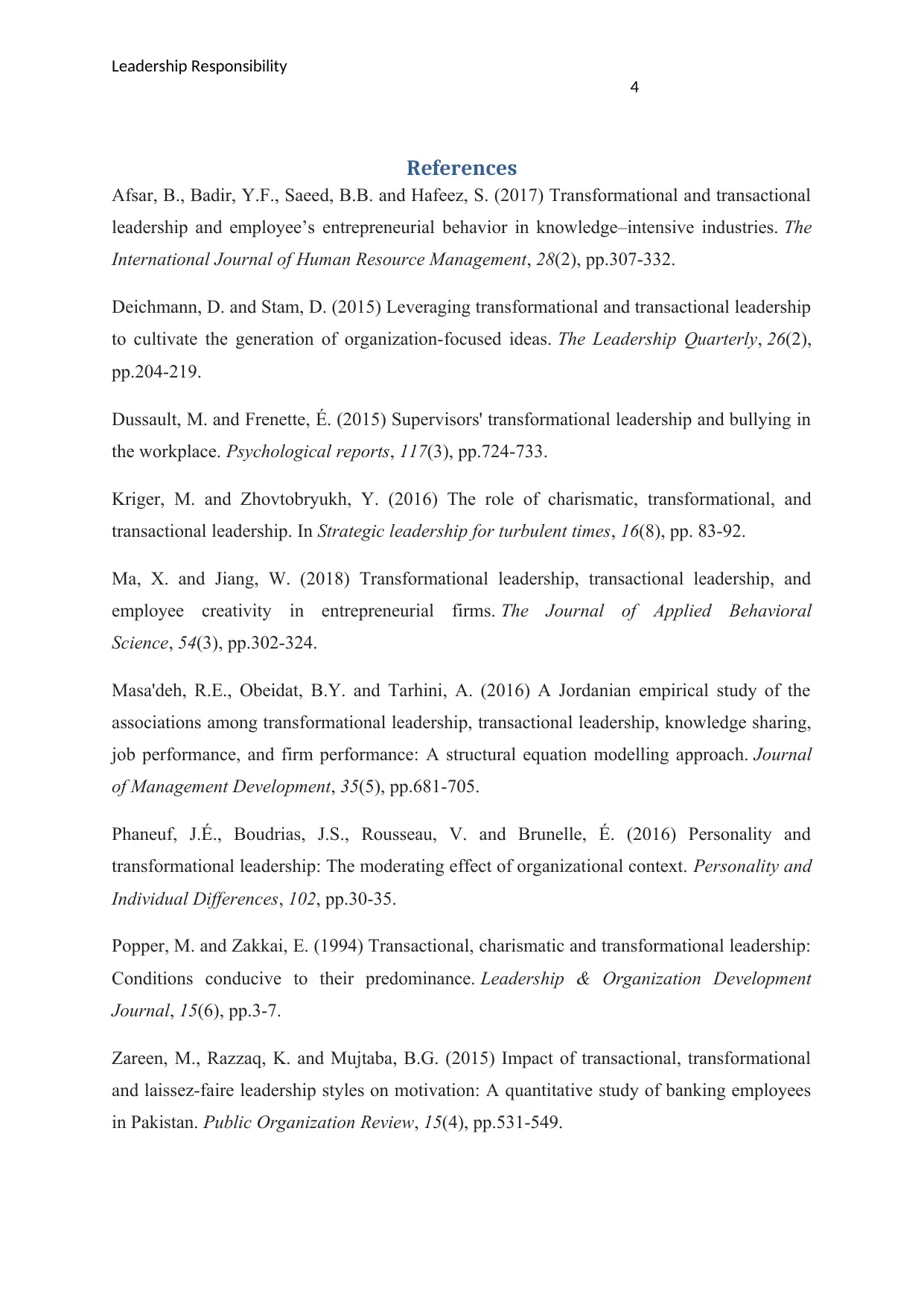
Leadership Responsibility
4
References
Afsar, B., Badir, Y.F., Saeed, B.B. and Hafeez, S. (2017) Transformational and transactional
leadership and employee’s entrepreneurial behavior in knowledge–intensive industries. The
International Journal of Human Resource Management, 28(2), pp.307-332.
Deichmann, D. and Stam, D. (2015) Leveraging transformational and transactional leadership
to cultivate the generation of organization-focused ideas. The Leadership Quarterly, 26(2),
pp.204-219.
Dussault, M. and Frenette, É. (2015) Supervisors' transformational leadership and bullying in
the workplace. Psychological reports, 117(3), pp.724-733.
Kriger, M. and Zhovtobryukh, Y. (2016) The role of charismatic, transformational, and
transactional leadership. In Strategic leadership for turbulent times, 16(8), pp. 83-92.
Ma, X. and Jiang, W. (2018) Transformational leadership, transactional leadership, and
employee creativity in entrepreneurial firms. The Journal of Applied Behavioral
Science, 54(3), pp.302-324.
Masa'deh, R.E., Obeidat, B.Y. and Tarhini, A. (2016) A Jordanian empirical study of the
associations among transformational leadership, transactional leadership, knowledge sharing,
job performance, and firm performance: A structural equation modelling approach. Journal
of Management Development, 35(5), pp.681-705.
Phaneuf, J.É., Boudrias, J.S., Rousseau, V. and Brunelle, É. (2016) Personality and
transformational leadership: The moderating effect of organizational context. Personality and
Individual Differences, 102, pp.30-35.
Popper, M. and Zakkai, E. (1994) Transactional, charismatic and transformational leadership:
Conditions conducive to their predominance. Leadership & Organization Development
Journal, 15(6), pp.3-7.
Zareen, M., Razzaq, K. and Mujtaba, B.G. (2015) Impact of transactional, transformational
and laissez-faire leadership styles on motivation: A quantitative study of banking employees
in Pakistan. Public Organization Review, 15(4), pp.531-549.
4
References
Afsar, B., Badir, Y.F., Saeed, B.B. and Hafeez, S. (2017) Transformational and transactional
leadership and employee’s entrepreneurial behavior in knowledge–intensive industries. The
International Journal of Human Resource Management, 28(2), pp.307-332.
Deichmann, D. and Stam, D. (2015) Leveraging transformational and transactional leadership
to cultivate the generation of organization-focused ideas. The Leadership Quarterly, 26(2),
pp.204-219.
Dussault, M. and Frenette, É. (2015) Supervisors' transformational leadership and bullying in
the workplace. Psychological reports, 117(3), pp.724-733.
Kriger, M. and Zhovtobryukh, Y. (2016) The role of charismatic, transformational, and
transactional leadership. In Strategic leadership for turbulent times, 16(8), pp. 83-92.
Ma, X. and Jiang, W. (2018) Transformational leadership, transactional leadership, and
employee creativity in entrepreneurial firms. The Journal of Applied Behavioral
Science, 54(3), pp.302-324.
Masa'deh, R.E., Obeidat, B.Y. and Tarhini, A. (2016) A Jordanian empirical study of the
associations among transformational leadership, transactional leadership, knowledge sharing,
job performance, and firm performance: A structural equation modelling approach. Journal
of Management Development, 35(5), pp.681-705.
Phaneuf, J.É., Boudrias, J.S., Rousseau, V. and Brunelle, É. (2016) Personality and
transformational leadership: The moderating effect of organizational context. Personality and
Individual Differences, 102, pp.30-35.
Popper, M. and Zakkai, E. (1994) Transactional, charismatic and transformational leadership:
Conditions conducive to their predominance. Leadership & Organization Development
Journal, 15(6), pp.3-7.
Zareen, M., Razzaq, K. and Mujtaba, B.G. (2015) Impact of transactional, transformational
and laissez-faire leadership styles on motivation: A quantitative study of banking employees
in Pakistan. Public Organization Review, 15(4), pp.531-549.
1 out of 5
Related Documents
Your All-in-One AI-Powered Toolkit for Academic Success.
+13062052269
info@desklib.com
Available 24*7 on WhatsApp / Email
![[object Object]](/_next/static/media/star-bottom.7253800d.svg)
Unlock your academic potential
Copyright © 2020–2025 A2Z Services. All Rights Reserved. Developed and managed by ZUCOL.





